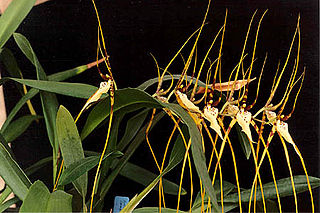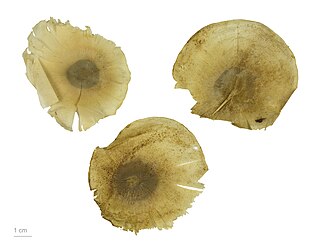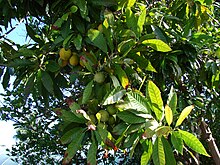
Chusquea is a genus of evergreen bamboos in the grass family. Most of them are native to mountain habitats in Latin America, from Mexico to southern Chile and Argentina.

Brassia is a genus of orchids classified in the subtribe Oncidiinae. It is native to Mexico, Central America, the West Indies, and northern South America, with one species extending into Florida.

The Sapotaceae are a family of flowering plants belonging to the order Ericales. The family includes about 800 species of evergreen trees and shrubs in around 65 genera. Their distribution is pantropical.

Chrysophyllum is a group of trees in the Sapotaceae described as a genus by Linnaeus in 1753.
Conceveiba is a plant genus of the family Euphorbiaceae, first described as a genus in 1775. It is native to South America and Central America.
- Conceveiba guianensisAubl. - Brazil, Peru, Bolivia, Ecuador, Colombia, Venezuela, 3 Guianas
- Conceveiba hostmaniiBenth. - Guyana, Suriname, Amazonas State in Brazil
- Conceveiba krukoffiiSteyerm. - Venezuela, French Guiana, NW Brazil
- Conceveiba latifoliaBenth. - Colombia, Venezuela, Peru, Amazonas State in Brazil
- Conceveiba martianaBaill. - Venezuela, French Guiana, NW Brazil, Colombia, Ecuador, Peru, Bolivia
- Conceveiba maynasensisSecco - Loreto in Peru
- Conceveiba parvifoliaMcPherson - Panama, NW Colombia
- Conceveiba pleiostemonaDonn.Sm. - Costa Rica, Nicaragua, Colombia, Venezuela
- Conceveiba praealta(Croizat) Punt ex J.Murillo - NW Brazil
- Conceveiba ptariana(Steyerm.) Jabl. - S Venezuela
- Conceveiba rhytidocarpaMüll.Arg. - Colombia, Ecuador, Peru
- Conceveiba santanderensisJ.Murillo - NW Colombia
- Conceveiba terminalis(Baill.) Müll.Arg. - Venezuela, Guyana, Suriname, NW Brazil, Colombia, Peru
- Conceveiba tristigmataJ.Murillo - Colombia, Venezuela, NW Brazil

Vriesea is a genus of flowering plants in the botanical family Bromeliaceae, subfamily Tillandsioideae. The genus name is for Willem Hendrik de Vriese, Dutch botanist, physician (1806–1862). Its species are widespread over Mexico, Central America, South America and the West Indies.

Sideroxylon is a genus of trees in the family Sapotaceae described as a genus by Linnaeus in 1753. They are collectively known as bully trees. The generic name is derived from the Greek words σιδηρος (sideros), meaning "iron", and ξύλον (xylon), meaning "wood."

Aspidosperma is a genus of flowering plant in the family Apocynaceae, first described as a genus in 1824. It is native to South America, Central America, southern Mexico, and the West Indies.

Pitcairnia is a genus of plants in the family Bromeliaceae, subfamily Pitcairnioideae. It was named for William Pitcairn, Scottish physician and gardener (1711–1791). The genus Pitcairnia ranks as the second most prolific of the bromeliad family. They are most abundant in Colombia, Peru and Brazil, but can also be found in areas from Cuba and Mexico south to Argentina. One species, Pitcairnia feliciana, is found in tropical West Africa and is the only member of the family Bromeliaceae not native to the Americas.

Eschweilera is a genus of woody plants in the family Lecythidaceae first described as a genus in 1828. It is native to southern Mexico, Central America, South America, and Trinidad.

Micropholis is group of trees in the family Sapotaceae, described as a genus in 1891.

Aegiphila is a genus of flowering plants in the mint family, Lamiaceae, first described in 1763. It was formerly classified in the Verbenaceae. It is native to Mexico, Central America, South America, the West Indies, and Florida.

Pradosia is a genus of plants in the family Sapotaceae described as a genus in 1872.

Rhodospatha is a genus of plant in family Araceae. It is native to South America, Central America, and southern Mexico.
Sarcaulus is a genus of plants in the family Sapotaceae described as a genus in 1882.

Chrysophylloideae is a subfamily of flowering plants in the chicle family, Sapotaceae.

Chomelia is a genus of flowering plants in the family Rubiaceae. It is native to Mexico, Central America, the West Indies, and much of South America as far south as Argentina.

Pausandra is a plant genus of the family Euphorbiaceae first described in 1870. It is native to Central America and South America.
- Pausandra fordiiSecco - Amapá, French Guiana
- Pausandra hirsutaLanj. - Peru, Brazil, Bolivia (Pando), Colombia (Amazonas)
- Pausandra macropetalaDucke - Brazil, Peru (Loreto), Venezuela (Amazonas)
- Pausandra macrostachyaDucke - Pará
- Pausandra martiniBaill. - French Guiana, Suriname, Guyana, Colombia, Venezuela, Peru, Brazil
- Pausandra megalophyllaMüll.Arg. - Rio de Janeiro
- Pausandra morisiana(Casar.) Radlk. - Brazil
- Pausandra trianae(Müll.Arg.) Baill. - widespread from Honduras to Bolivia

Ecclinusa is a genus of plants in the family Sapotaceae described as a genus in 1839.

Elaeoluma is a genus of plants in the family Sapotaceae described as a genus in 1891.



















